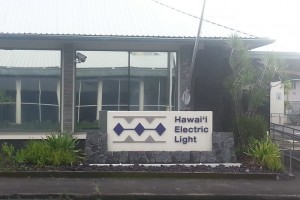Hawaiian Electric Sets Renewable Energy Plan
Hawaiian Electric Companies has submitted its Power Supply Improvement Plan Update to the Hawai’i Public Utilities Commission, laying out its direction in getting the state to 100 percent renewable energy over the next 30 years.
In the detailed plan, Hawaiian Electric hopes to have the Big Island reaching 100 percent renewable energy by the year 2040, ten years behind Moloka’i and Lāna’i and five years ahead of the statewide goal of 2045.
To achieve 100 percent renewable energy levels, Hawaiian Electric hopes to utilize a mix of private rooftop solar energy, feed-in-tariff solar energy, utility-scale solar energy, onshore wind energy, offshore wind energy, hydropower, and geothermal energy.
Hawaiian Electric also aims to increase rooftop solar levels by 250 percent from current levels and 370 percent from levels recorded in 2014, which was the last time the utility company submitted a Power Supply Improvement Plan.
Proposed plans by Hawaiian Electric to achieve its 100 percent renewable energy goal include:
- Implementing a smart grid by installing the modern wireless network, smart meters, and other enhanced technology to modernize the existing power grid, increase customer options, and improve the integration of distributed energy resources.
- Issuing Requests for Proposals for a variety of renewable energy projects with a combined capacity of more than 350 megawatts to be developed by 2022. With PUC approval, these projects would be developed through a competitive process and located on O‘ahu, Hawaiʻi Island, Maui, Molokaʻi, and Lānaʻi.
- Taking the next steps to pursue the benefits of LNG, which can serve as a lower-cost, cleaner fuel during the transition to 100 percent renewable energy
- Supporting the continued growth of private rooftop solar through new programs.
- Implementing a Demand Response Management System to provide customers with more options and to increase integration of rooftop solar.
- Installing circuit level improvements on all islands to safely and reliably integrate renewable energy.
- Pursuing energy storage options, including both utility-scale systems, energy storage integrated with rooftop PV systems, and pilot programs evaluating new technologies.
- Implementing Community-Based Renewable Energy to allow customers who cannot or choose not to take advantage of rooftop solar to receive the benefits of participating in a renewable energy program.
- Retiring utility generation that is not ideally suited to support the integration of renewables, including four O‘ahu generators at Kahe Generating Station, two at Waiau Power Plant, as well as four generators that make up the Kahului Power Plant on Maui, and one steam generator in Puna.
- Modifying and improving existing generation to help facilitate the integration of variable renewable generation.
- Microgrids at military facilities that operate in complementary fashion interconnected to the utility grid and provide resiliency and energy security for customers by using diversified locations for firm generation.
Additionally, Hawaiian Electric plans to ask the PUC for permission to move ahead with a contract that would import liquefied natural gas, also known as LNG, as early as 2021. The goal is to phase it out by 2040.
LNG is used for electricity generation and is supposed to be a cleaner, less volitile, and cost efficient option. On the Big Island, it is proposed for the Keahole and Hamakua Energy Partners plants.
A major part of the plan hinges on the pending merger with NextEra Energy, based on its financial support and expertise. Hawaiian Electric plans to go through with plans to reach 100 percent renewable energy, but admits that a different contract with lower, delayed savings would be likely on its own.
Sponsored Content
Comments









